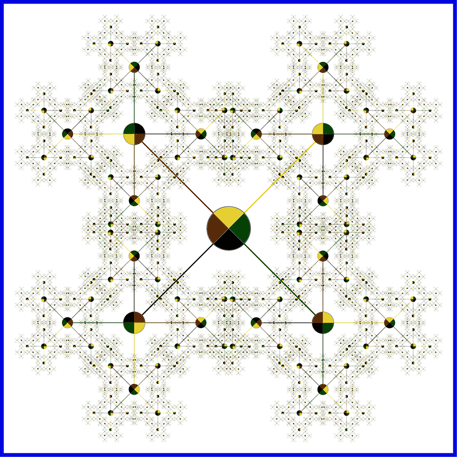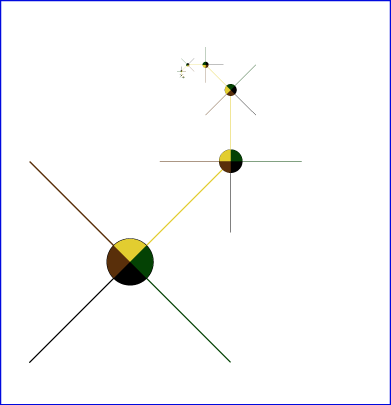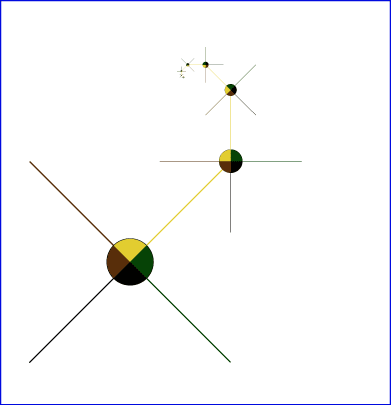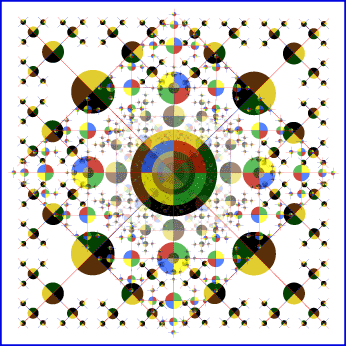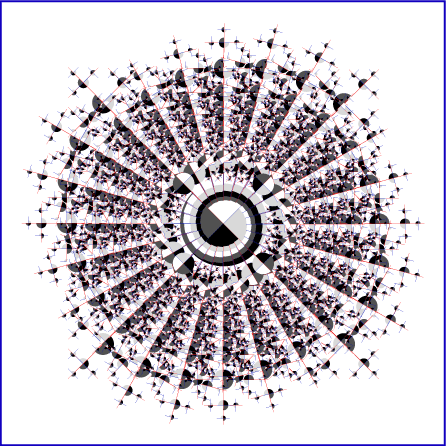
Go ahead and reduce that circle 50% — but remember —
just to get back to where you started, you’re going
to have to increase what’s left by 200%.
Now think about the planet, and that circle. Think long and heartfully
about human sentience, and the delicate circles of organismal
assembly it arises only in communion with. Then think
about what machines do in a living cell-world.
Take a moment to consider that in your world, today, almost all
of the terrain-space your sentience and person requires —
is occupied by machines, their transports of resource acquisition,
support system, and their outputs.
On Earth, circa 2004, a car automatically
has more rights and terrain — and rights
of passage, than a human being. Particularly the form of human
being you refer to as a child. Lest you think this is merely a
physical problem, consider that your own cognition is born and
evolves primarily in reflection of your experiential (not merely
your conceptual) environ ment.
Warning:
Errors are not what we have been taught
to believe,
and ‘mistakes’ do not mean what we have
been told.
The instances of a poe on these pages may
contain ‘errors’
— on purpose —
and some of the errors are in the form of ‘correctness’...
A single-phase, linear-clockwise, 5-loop poe
(point of entrance) — 90-degrees.
This toy transcends its planar dimensionality in multiple
simultaneous domains. What’s useful about this toy
is not visible, however — it is what you can learn playing
with it, and other toys like it.
Once you’ve seen it — you own it. It can’t
be ‘taken away’ or sold — or even reliably
named. No one but you will even know you have one.
And no one else’s can ever be precisely like yours...
Although this is not saying enough — no
single observer, is a single observer — except at a given scale, under the rule of a separatory
paradigm. Nature never produces anything for or about
which only one perspective is available. The truth is always a version
of multiply distinct simultaneity. There is a cognitive
gesture alike with this which you are already an expert with, but
do not interact intentionally with. If you do, your powers of sentience
change, and they change radically.
This ‘gesture’ is essentially an emotional, poetic and
intellectual movement of connectivity with ‘very small’
sources.
If you are merely allowed to notice yourself
making this gesture, you will shortly thereafter encounter
an agent of the primordial sentience, directly.
Presuming you’re of welcoming temperament,
this agent will introduce you to domains of experience, ability,
understanding and knowledge beyond all possible fiction —
and far beyond science and religion as we currently model them in
the common domains of storying and metaphor.
o:O:o
Classical understandings of dimensionality, like those we are largely
obliged to accrue in educational systems are false. The reason is
not that they are untrue in their logics — but that their
access to a varied set of perspectives is totally missing. In other
words, living geometries utilize multiply recombinant non-local
relation. The assemble logics from a vast array of equally valued
perspectives of truth, and even of assembly. Comparatively, our
common human modes — even the most elegant and esoteric —
are flat, and myopic. While mechanically factual, they
are founded in root-positions that mismetaphy (make broken meaning-root
values for) ‘dimension’ based on a single source-perspective — a basis nowhere apparent in Nature.
o:O:o
I believe our species will soon discover that what
is missing as one ‘goes down the ladder’ of dimensions
— is ‘more than made up for’ in myriads of explosively
expansive terrains that we have neither metaphor for, nor story
of. In other words when we go from 3 s to 2 — the one we subtracted
has grown huge (in significance, character and content) in a place
we cannot yet refer to. We haven’t invented an even generally
accurate metaphor to refer with...yet.
The crazy thing about dimensions that humans are about to discover
is this: when you remove one somewhere, 12 others of vast import
arise invisibly in response.
And this whole game is deeply related to how and
why our species has sentience...and what the real potentials of
this ancient gift actually are.
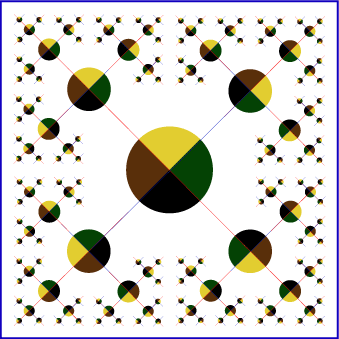
The
wisest first move you can make, is to hinder your desire to compare
this image in the figure above to anything you are ‘already
familiar with’. In fact, it would be best if right here,
you (somewhat playfully) decided that no one can know
‘what this is’. Part of the reason is that it isn’t
a what, so much as it is a kind of model of one possible
mode of a living how...
It
isn‘t a ‘fractal’, nor some similar
‘mathematical’ construct; though such formalisms might
be accurately applied to it. This is not a representation of a
formalism — even if after hearing my advice you disagree
and decide that it is (which, in this case, would be an error).
And yes, it could be the product of a formal assembly procedure
— yet this does cannot prove that it is.
To
obtain access to its usefulness — and
this has to do with a sort of movement — it is important
to not decide ‘what it is’. It
is exceptionally more useful to let its primary identity remain
uncertain, and to actively pursue models and toys, or strategies
of ‘seeing what it is like’ from various active
perspectives, without ever ceasing at one as the ‘thing
it is most like’. The idea is to value this uncertainty,
and follow it — more than any other possible idea about
this toy.
The
thing up above this text isn’t ‘an image’ —
and the unimage it isn’t is ‘something like’
a metaToy. It’s not meant to be decided about —
but played with. If you‘re bored by it,
you’ve chosen to stop playing — and this
is the only mistake you can make with this toy.
This
whole naming thing is a serious problem here. Since I am writing
in text, I must find some way to reference this (version of a
possible) metaToy in a way that tends more to release us from
labels and classes and comparators than it does to bind us to
them.
The
‘thing somewhat like an image’ above isn’t even
‘the thing I am trying to talk about’, but merely
a single-phase representation of one possible toy of
what I am trying to speak toward. See how thinking ‘this
is a metaToy’ is already binding me to repetition? I am
becoming trapped because I made the deadly error (in this particular
game) of binding to a token of reference — which
is the opposite of what I am attempting to do.
o:O:o
Perhaps I should explain a little bit about this (position of
entrance) visible above, and how it was made. As I am writing
this, I am using it — and it wants me to make
more of it, which I would prefer to do in text, rather than
in an illustration program. (six days later I am still making
‘more of it’ — see below). The kind of more
it wants is not something we’d expect: it wants more
ways to be uniquely embodied relational similarities
of itself...
In considering ways I might make more of it — I entertained
the idea that I could link each ball in the representation
to an entire tree-like (poe) like the one above — such that
clicking any ball would reveal that it is the center of a uniquely
embodied poe in an adjacent dimension. And then in each of those
images, I could link each ball similarly. I got frightened when
I started wondering about what I might do with the ‘angles’
and ‘points’ in the poe.
The ‘strategy’ of its construction is simple. Create
the center circle, add an ‘x-cross’ to demarcate the
sections of color, extend its arms half a diameter at each of
the four exits from the circle. Then ’copyMove’ this structure to the end of a crossArm,
and turn it 90 degrees. Then shrink it by half. It took about
three hours to successfully construct the first simple example,
and the model is imperfect — however it was not meant to
be a perfect model.
Later,
I began to experiment with a poe of twice the complexity of these
models. These 5-tier (meaning move 5 nodes to get to a ‘sameness’
of color-position on the wheel) poe-crosses (poe-ts) utilize a
90-degree spin across the their ‘gaps’ or rods. If
one were to halve that, one would...of course, radically affect
both the complexity and the geometric diversity of the poe.
This
is a cognitive toy, not a mathematical one...
We
might proceed to play with the poe as a toy of points, and rods,
and circles (or, if we prefer ‘wholes’).
Every
‘whole’ has a hole in its center (which is
a transport of exceptional unityFeatures, rather than ‘something
missing’). These are polarities — such that the ‘distance’
between one and the other is ‘none’ yet on each ‘side’
of the hole there is a unique and complete universe. They are
‘all the same hole’ (i.e: a single ‘point’),
yet in every position— what they lead to is at once unique
and complete.
They
are the realm of the point — in the poe.
Each
of these points, or holes is touching every other point. We might
imagine that at any ‘given size’ every other ‘hole’
(at that size) is ‘present’ such that one can step
through a door zero distance away and step through in any other
position (at that size). Had we chosen to imagine the previous,
we might then proceed to assert that a ‘change of size’
was ‘one step’ away — so that from the
center of any circle, one could ‘take one step’ and
land in the center of any circle ‘one step’ larger
or smaller than one’s current size.
There is an ‘opposite’ sort of gap — an anti-hole
— at the places where the rods of the crosses meet and change
color (theoretically ‘halfway’ between the circles
they connect, although this varies in the representation above).
Those holes lead to similar structures in an invisible (in this
representation) domain. Thus there are many scales, and dimensions
which are not visible in this poe. We might, for example, imagine
that the anti-holes in the rod-centers lead to the centers of
circles in distributed universes of anti-poes...
This
poe appears designed for linear-clockwise travel, such
that travel out from any point (along rods) results in clockwise
spiraling (when we examine the travel and the result) Thus movement
along the poe — via holes or lines or following edges of a
circle — has interesting results.
One
can take the scenic route, around a circle — and stay in
the neighborhood.
One
can follow a rod, and change direction at any centerpoint.
One
can take ‘the shortcut’ by going to the center of
the circle, and emerging either at or near one’s intentional
destination-point.
And
of course, one can combine these movements in any desired order.
Theoretically,
given the toyRules I’m presenting, one could leave this
toy entirely, and move to another invisible toy via the unHole
at the centerpoints where the rods change color.
Seen
as a toy of sentient migration, no matter ‘where one is
going’ one is always ‘almost there’. Some methods
of travel speed up or slow down as the scale of their locality
shrinks or expands. There are many interesting (and useful) features
to this simple poe. But tracing paths on an image is boring, and
mostly useless.
How
is the poe activated such that it becomes a useful toy, rather
than a mere object of speculation?
In order to understand this, we need to see things with great
generality, such that we can use this simple model to paint portions
of some majestically complex scenarios... which happen through
the unique expressions of relation emergent from them...to grant
us the sources and ongoing presence of our complexly human sentience.
Primarily, this is a toy of relation, and it’s most significant
purpose is to erase itself, by offering experiential access to
the fact that there is nothing else, and locality is only a tiny
portion of the equation.
I’m not much interested in boring you with semantic exercises,
but before we continue I want to ask a simple question: have you
ever seen a picture of a concept?
In other words... what does a picture of the idea of
Tree look like? It doesn’t necessarily look like
anything at all — but that doesn’t mean we can’t
make a generally accurate model — as long as we remember
we are really just playing with toys. If the picture we make is
generally accurate enough, it can have a seemingly impossible
repercussion — it radically alters what a concept is —
in our minds, experience and cognition. The reason is simple:
All human thinking is based on models. And these are
based in turn on schemas of assembly. If we have access only to
the models, we are living in a cage that cripples our natural
potentials and divides us from each other and our experience.
If we have direct access to recombinantly fractured schemas —
this matter resolves itself.
So what I am getting at is that it is possible to create a toy
that changes how humans relate with their own tokens of sentience:
metaphors — and also grants them many new options of assembly
and interaction, including a vast catalogue which in the modern
moment we as a Western People would consider utterly impossible.
In the face of such a suggestion, myriads of questions are bound
to arise in response to our sometimes useful habits of skepticism.
Most of them can be addressed very easily. For example, a common
response is along the lines of: well if something this accessible
and simple were possible, we’d
already be doing it, because as a species we are far more scientifically
advanced that was ever imagined possible...
But this is not the case, for our advancement, while real, has
been in a strange domain that denies and often directly opposes
advancement along other channels. Usually, when our species is
subject to this cognitive disease, the ascendant paradigm begins
loudly mimicking those things it by its nature denies access to
— thus we have, for example, vast bureaucracies and prisons
to support ‘justice’, without ever having access to
anything but that single very broken definition. The existing
structures take up so much terrain and space that they idea of
radically altering them appears impossible. We settle for an outcome
which is a lot like inviting an imposter of someone we would admire
home for dinner — based upon what they imitate, rather than
the outcome of their actions, and the actual reality of their
activity.
[When we apply a frozen metaphor to a toy of knowing, we ‘close
the transport at the center’, and this results in sentience
damage, broken toys, human atrocity, and probably even dead worlds.]
A ten-tier poe
(almost eight days were required to complete this —
this is the sixth complete version).
This represents a toy of the general schema of a cognitive
transport with impossible powers of transtemporal and translocal
presence. It expresses a 45-degree counterclockwise spin (out)
from ‘core-north’ (yellow in largest node). The last
position (tail) recapitulates the first (crown). i.e: 1 = 10 (and
all positions with(in)) We can play with this as one simple instance
of a ‘toy’ that acts as a cognitive magnet...when
played with attentively.
To assemble something of this nature accurately one must first
explore the contextual features of the background, and schema.
In doing so, many unexpected discoveries are made, and must be
addressed in order to proceed. This ends up becoming a self-referencing
process that requires one to experientially explore domains of
self-reference via sR, in order to produce an image-artifact that
is based in a scalar sR movement. The most important thing about
all of this is that it should lead us to explore how we create
metaphors and meaning — and where we got our models of this
process from. In other words, this is a cognitive toy —
not a ‘piece of art’ or a ‘math-object’.
One must (in process of assembly) attend matters
of distortion at scales as one builds ‘back’ from the
smallest parts, toward the initial entrance structure.One must also
do what a computer cannot — which is to allow the patterns
emergent in the very small to dictate the math, rather
than the other way around — at least in the method of assembly
I was using.
The pattern goes something like this:
explore
arm establishment — each arm appears in node-steps, in a spiral
complex (spiraling back) assembly of nodes.
The file complexity (and size) grows ‘in a progression’
which we would characterize as ‘geometric’ (a definite
pun in this case) in size as each ‘cross-section’
is duplicated; 4 times for each node, at every scale, in all four
positions. Due to the profound complexity of the final two phases,
I was unable to assemble more accurate models than those presented
because the file quickly grew from 184k to 132.3mb. Illustrator
was unable to handle the file at all much beyond the ‘spin
duplication’ of the third major cross.
As well as what is visible, there is also a stairstep effect such
that the first smallest cross is underneath the next, in a spiral,
at every scale. The cross in the upper right is lowest, and the
upper left highest (in this model). The variance in the coloration
and detail below is due to the different modes required to produce
an image for the stage-steps, and the final object.
This is another toy of something alike with a portion
of the likeness of the ‘tree of life’ or the ‘tree
of lights’. All positions are interdependent— thus,
for example none may be attacked without attacking all positions...and
the same is true of nurturence, or celebration...
A (single-arm view) of (one mode) of the assembly
of this poe(t).
Select one rod as ‘nodeNorth’ — yellow is ‘nodeNorth’
in this model.
Rotate (45 degrees in this case) a half-sized copy of the topMost
node, and place it at the end of this rod. Continue, following‘localNorth’
at each successive node, until the last node’s ‘color-position’
matches the first.
[More properly (such as in the imagination) this is done in a
circular pattern, clockwise or counter from core, thus that each
second node would be applied in order, then the north third, and
so on.] In a ‘more accurate’ poe, the first tier of
four nodes would phase-in, properly spun, followed by the second
tier (of 4 x 4), &c.
Alternately (and much more interestingly), the arisal of the
‘biggest’ node, would be followed by the sudden and
universal arisal of ‘all of the smallest nodes’. These
would arise spirals within spirals. These would be followed by
the second largest, followed by the second smallest, &c. The
secret of the poe is that each node and line is built of ‘other
scales and forms’ of poes... alike with the final product
above (in a very general way).
The final node gets four orbitals.*
Each node in order, local-north first would
be elaborated in spin-direction at each position on the four
arms —
and each step would proceed thus.
We traveled down the arm to establish foundations
— we now begin traveling back (in a sense) — establishing
complexity.
*(in the illustration the final node ‘becomes an
orbital’ of its progenitor, and 3 new orbitals
are added — this is for file-size simplicity. Though
the illustrations follow the model described here, another
mode of assembly would follow the schema illustrated (and
counted) through the following phases.)
The final node and its orbitals orbit its
progenitor.

(256x4)
(768 are added)
(1024x4)
(3072 are added)
(4096x4)
(12,288 are added)
In a poe being assembled in a balanced fashion,
the numbers at each phase would quadruple. For example, if
we recognize that there are 10 ‘size-speed’ dimensions
in the poe, we can see that what is being multiplied is not
merely ‘structure’ or foreground. In fact, with
each addition to the poe, multiple dimensions of new potential
location and relation are being established in a dance that
proceeds geometrically in form, numerism, poetic — and
even magical domains.
This is one form of a dimension-multiplying
toy.
This
figure offers a flat animation of the growth of a single arm.
It is a very simple model of how a biocognitive hyperstructure
evolves — but it is profoundly useful in allowing us
access to an active metaphor that can encourage us to change
our relations with specific holophores — Time, for example.
The above images comprise‘toys of a schema’
— or something like a map that shows ‘a way of making’
ways — rather than maps or ‘an instance
of product’.
Here is an image of an unobject — which is a ‘product’
of sentient creatures ‘playing together in reMembrance with
the sources of the poe’. It is more alike with the metaphor
‘door’ than it is with ‘picture’ —
but our common objectification habits cause us to generally exchange
this potential of a recominbinantly scalar game of rescue-explorations
which provides egress — for that of its opposite —
an object that provides stability: It represents something which
is entirely unapparent : a way of moving in and out...of everyWhen
and anywhere, and any combination thereof — within the unityBeing.
Start and first-phase finish of a 24-ray
(15 degree) poe.
Note the complex mesh of poe-larities (rods
with their central un-holes) along the rays.
o:O:o
|


